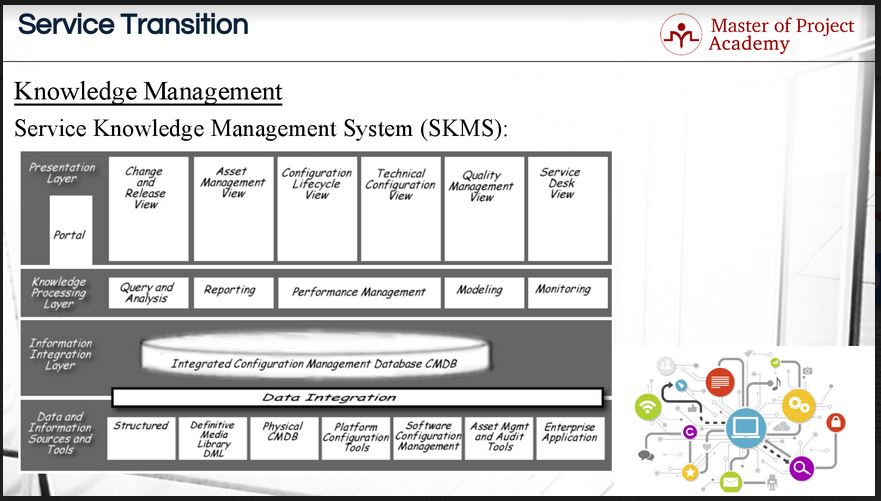Knowledge is hard to manage. We often have lots of data but little information and knowledge. We are not always sure what knowledge is valuable and what is not. Furthermore, tribal knowledge or experience is hard to document. Too often, pockets of data reside in many sources and tools. Controlling the accuracy and currency of knowledge in a database can be challenging. The ITIL concept of Service Knowledge Management Systems is an answer to these difficulties. Service Knowledge Management System is abbreviated as SKMS and is a set of tools and databases that are used to manage knowledge and information. All services, components, assets, documentations, applications, databases, etc. all constitute the SKMS of an IT Service Provider. The SKMS concept was developed as part of the ITIL training guidelines. It forms part of the ITIL Service Transition stage of the ITIL Lifecycle as taught in ITIL online courses.

The SKMS includes the configuration management system as well as other tools and databases. Since the configuration management system is a system that helps an IT service provider to manage its service delivery to the customer, it is part of the SKMS. Similarly, the configuration management database, known error database, definitive media library, etc. are all parts of the SKMS.
The SKMS stores, manages, updates, and presents all information that an IT service provider needs to manage the full lifecycle of an IT Service. In summary, all services and its details, documentations, etc. are controlled under the SKMS with the help of other systems and databases.
The four layers of the SKMS
This figure visualizes the four layers of the Service Knowledge Management System. The first layer is the Data and Information layer. This layer includes configuration management database, definitive media library, known error database and other management, configuration and audit tools and applications.
The second layer is Information Integration layer. This layer helps to evaluate and analyze the data from the first layer and relationships are structured in the integrated configuration management database.
The third layer is Knowledge Processing layer. Information is analyzed, reported, modeled and monitored to access knowledge.
The fourth and the last layer is the Presentation layer. From first to the third layer, data has been processed to obtain information and knowledge. And at the fourth stage, the structured and meaningful knowledge is processed and presented to draw further conclusions.

Misconceptions about SKMS
Some think that deploying a Service Knowledge Management System means that various service information sources will be stitched together during a custom systems integration project. The heterogeneity of data and diversity of tools in organizations makes some doubt whether SKMS is indeed a useful tool. Yet, ITIL guidance encourages the use of SKMS as a knowledge platform rather than a solution for problem resolution. This in an important point of differentiation. SKMS is not a customized integration of data sources, but rather a knowledge platform that will overcome IT information silos.
IT organizations tend to work in distinct silos with barriers between different sets of information storage systems that are based on technology rather than how IT supports the business. Various service processes are owned by separate teams in isolated silos. This is where a Service Knowledge Management System is a useful solution – it dissolves the information silos and provides one organization-wide knowledge platform
Another misconception is to think of a Service Knowledge Management System regarding structured data only. It’s not just a set of databases such as configuration management databases, service desk data, response time data, etc. A genuinely useful SKMS includes a wider range of knowledge items gathered from diverse sources of information. It includes not only structured data but also semi-structured data such as machine-readable text with tags or unstructured data such as human readable information e.g. documents or web content. The amount of unstructured data available is often underestimated and is said to comprise nearly 80% of all of an organization’s data. Most of the SKMS body of knowledge will consist of unstructured data.
Barriers to adopting SKMS and how to think differently
The most common barriers to adopting a Service Knowledge Management System in an organization include the following:
- Data is stored in different formats of structured, semi-structured and unstructured data. Unlocking this data requires different methods and tools.
- Much of the data sits inside individuals’ heads. Recording this requires time and effort.
- Publishing this data requires yet another tool or multiple tools.
- It’s impossible to keep up with the rapid growth of data.

Instead of thinking in this way and avoiding the adoption of an SKMS, the following questions should enter your mind instead:
- What are the potential benefits
- What is the quantified value?
- Is there any low-hanging fruit?
- What are the most promising solutions to picking the low-hanging fruit and establishing long-term growth potential?
The benefits of SKMS far outweighs its negatives. Getting stuck in the barriers of adopting an SKMS for an organization can hamper the IT service provider’s ability to fully harness all the information available within the organization.
Service Knowledge Management Systems tie together all the information that is needed and collected during the ITIL Service Transition stage of the ITIL service lifecycle. Once all the knowledge is contained in one place, it is easier to access information in the ITIL Service Operation and Continual Service Improvement stages. While many may think that deploying an SKMS is a lot of hard work for little reward, they would be surprised in realizing that an SKMS is a tremendously useful tool in IT service management.

Interesting pointers on the how & what of Service Knowledge Management System.. Good read!